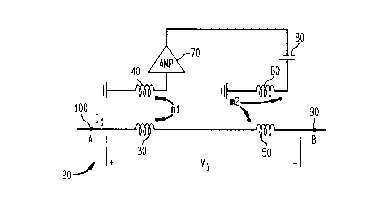Some of the information on this Web page has been provided by external sources. The Government of Canada is not responsible for the accuracy, reliability or currency of the information supplied by external sources. Users wishing to rely upon this information should consult directly with the source of the information. Content provided by external sources is not subject to official languages, privacy and accessibility requirements.
Any discrepancies in the text and image of the Claims and Abstract are due to differing posting times. Text of the Claims and Abstract are posted:
| (12) Patent: | (11) CA 2245803 |
|---|---|
| (54) English Title: | IMPEDANCE REGULATOR SYSTEM AND METHOD |
| (54) French Title: | SYSTEME ET METHODE DE REGULATION D'IMPEDANCE |
| Status: | Expired and beyond the Period of Reversal |
| (51) International Patent Classification (IPC): |
|
|---|---|
| (72) Inventors : |
|
| (73) Owners : |
|
| (71) Applicants : |
|
| (74) Agent: | KIRBY EADES GALE BAKER |
| (74) Associate agent: | |
| (45) Issued: | 2000-10-31 |
| (22) Filed Date: | 1998-08-25 |
| (41) Open to Public Inspection: | 1999-03-10 |
| Examination requested: | 1998-08-25 |
| Availability of licence: | N/A |
| Dedicated to the Public: | N/A |
| (25) Language of filing: | English |
| Patent Cooperation Treaty (PCT): | No |
|---|
| (30) Application Priority Data: | ||||||
|---|---|---|---|---|---|---|
|
An impedance regulator system and method which offers
a large effective high-frequency block to isolate RF signals
transmitted on power lines is presented. High-current
inductors in series are inductively coupled over the RF band
to physically smaller, low-current coupling inductors. The
coupling inductors induce a degenerative or canceling at RF
frequencies in the high-current inductors, resulting in the
effective inductor increase and hence higher impedance over
the RF band.
L'invention est constituée par un système et une méthode de régulation d'impédance dans lesquels un volumineux bloc haute fréquence efficace est utilisé pour protéger les signaux RF transmis sur les lignes de secteur. Des bobines en série à courant élevé sont couplées inductivement sur toute l'étendue de la bande RF à des bobines de couplage à courant faible plus petites. Ces bobines de couplage produisent un effet dégénérateur ou éliminateur aux fréquences RF dans les bobines à courant élevé, ce qui accroît l'efficacité de ces bobines et, par conséquent, l'impédance dans la bande RF.
Note: Claims are shown in the official language in which they were submitted.
Note: Descriptions are shown in the official language in which they were submitted.

2024-08-01:As part of the Next Generation Patents (NGP) transition, the Canadian Patents Database (CPD) now contains a more detailed Event History, which replicates the Event Log of our new back-office solution.
Please note that "Inactive:" events refers to events no longer in use in our new back-office solution.
For a clearer understanding of the status of the application/patent presented on this page, the site Disclaimer , as well as the definitions for Patent , Event History , Maintenance Fee and Payment History should be consulted.
| Description | Date |
|---|---|
| Time Limit for Reversal Expired | 2002-08-26 |
| Letter Sent | 2001-08-27 |
| Grant by Issuance | 2000-10-31 |
| Inactive: Cover page published | 2000-10-30 |
| Inactive: Final fee received | 2000-07-25 |
| Pre-grant | 2000-07-25 |
| Notice of Allowance is Issued | 2000-02-24 |
| Letter Sent | 2000-02-24 |
| Notice of Allowance is Issued | 2000-02-24 |
| Inactive: Approved for allowance (AFA) | 2000-02-03 |
| Application Published (Open to Public Inspection) | 1999-03-10 |
| Inactive: IPC assigned | 1998-11-04 |
| Inactive: First IPC assigned | 1998-11-04 |
| Inactive: IPC assigned | 1998-11-04 |
| Classification Modified | 1998-11-03 |
| Inactive: Filing certificate - RFE (English) | 1998-10-14 |
| Filing Requirements Determined Compliant | 1998-10-14 |
| Application Received - Regular National | 1998-10-13 |
| Request for Examination Requirements Determined Compliant | 1998-08-25 |
| All Requirements for Examination Determined Compliant | 1998-08-25 |
There is no abandonment history.
The last payment was received on 2000-06-27
Note : If the full payment has not been received on or before the date indicated, a further fee may be required which may be one of the following
Please refer to the CIPO Patent Fees web page to see all current fee amounts.
| Fee Type | Anniversary Year | Due Date | Paid Date |
|---|---|---|---|
| Request for examination - standard | 1998-08-25 | ||
| Registration of a document | 1998-08-25 | ||
| Application fee - standard | 1998-08-25 | ||
| MF (application, 2nd anniv.) - standard | 02 | 2000-08-25 | 2000-06-27 |
| Final fee - standard | 2000-07-25 |
Note: Records showing the ownership history in alphabetical order.
| Current Owners on Record |
|---|
| AT&T CORP. |
| Past Owners on Record |
|---|
| WOODSON DALE WYNN |